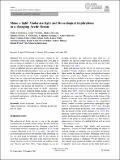Shine a light : under-ice light and its ecological implications in a changing Arctic Ocean
Abstract
The Arctic marine ecosystem is shaped by the seasonality of the solar cycle, spanning from 24-h light at the sea surface in summer to 24-h darkness in winter. The amount of light available for under-ice ecosystems is the result of different physical and biological processes that affect its path through atmosphere, snow, sea ice and water. In this article, we review the present state of knowledge of the abiotic (clouds, sea ice, snow, suspended matter) and biotic (sea ice algae and phytoplankton) controls on the underwater light field. We focus on how the available light affects the seasonal cycle of primary production (sympagic and pelagic) and discuss the sensitivity of ecosystems to changes in the light field based on model simulations. Lastly, we discuss predicted future changes in under-ice light as a consequence of climate change and their potential ecological implications, with the aim of providing a guide for future research.
Citation
Castellani , G , Veyssière , G , Karcher , M , Stroeve , J , Banas , S N , Bouman , A H , Brierley , S A , Connan , S , Cottier , F , Große , F , Hobbs , L , Katlein , C , Light , B , McKee , D , Orkney , A , Proud , R & Schourup-Kristensen , V 2021 , ' Shine a light : under-ice light and its ecological implications in a changing Arctic Ocean ' , Ambio , vol. First Online . https://doi.org/10.1007/s13280-021-01662-3
Publication
Ambio
Status
Peer reviewed
ISSN
1654-7209Type
Journal article
Description
This study was supported by the Changing Arctic Ocean projects EcoLight (03V01465), Arctic PRIZE (NE/P00573X/1; NE/P005721/1), Diatom-ARCTIC (NE/R012849/1; 03F0810A), MiMeMo (NE/R012679/1), CHASE, Peanuts (NE/R012636/1) and Diapod (NE/P005985/1) jointly funded by the UKRI Natural Environment Research Council (NERC) and the German Federal Ministry of Education and Research (BMBF). VSK was funded by the FRontiers in Arctic marine Monitoring program (FRAM). Open Access funding enabled and organized by Projekt DEAL.Collections
Items in the St Andrews Research Repository are protected by copyright, with all rights reserved, unless otherwise indicated.

